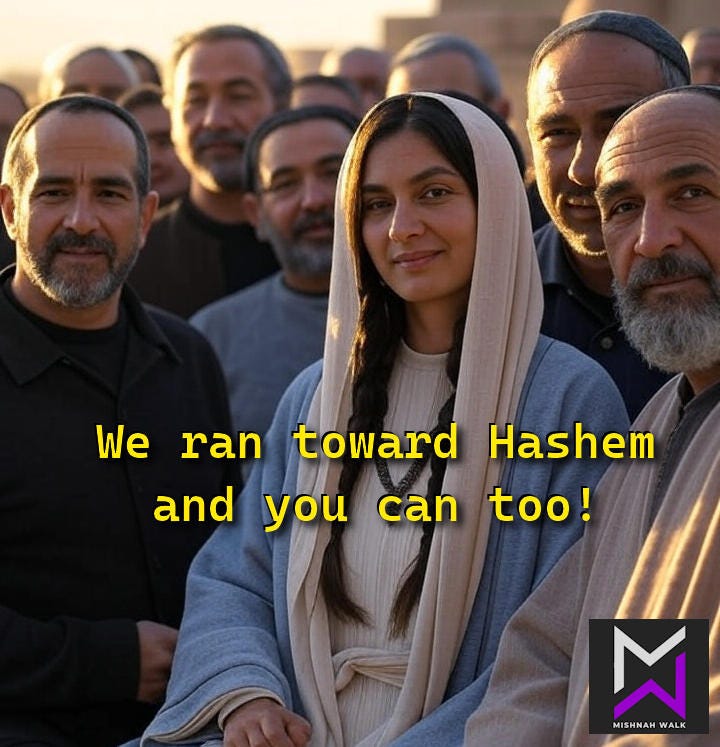The Tanakh weaves a powerful narrative of individuals and groups eagerly entering into covenant with Hashem (YHWH) and Israel, driven by awe for Israel’s mighty God and respect for His chosen people. From the mixed multitude of the Exodus to the Kenites’ integration, these stories reveal a consistent theme: people are drawn to join Israel and worship Hashem, not to leave. Those who depart do so only against their will, typically through divine expulsion for covenant violations. Yitro’s righteous offerings and his descendants’ alignment with Israel highlight this desire to embrace the covenant, suggesting an evangelical role in spreading Hashem’s truth. This article explores key examples of this covenantal embrace, culminating in a summary of the universal longing to join and remain with Israel’s God.
The Mixed Multitude: Awe-Inspired Embrace
In Exodus 12:38, a “mixed multitude” (erev rav) joins the Israelites during the Exodus, captivated by reverence for Hashem’s power, demonstrated through the plagues and Passover. This diverse group, likely including Egyptians and other slaves, aligns with Israel, participating in the covenant at Sinai (Exodus 19-20). Their embrace reflects awe for the God who delivered Israel and respect for the nation chosen to carry His covenant, mirroring the fervor of those drawn to a great people under divine favor.
Rahab and Her Household: Faith-Driven Commitment
Rahab, a Canaanite from Jericho, embodies covenantal embrace in Joshua 2:9-11, declaring, “The Lord your God, He is God in the heavens above and on the earth beneath.” Her awe for Hashem’s mighty acts and respect for Israel’s divine mission lead her household to join the Israelites after Jericho’s fall (Joshua 6:25). Integrated into Israel, her voluntary alignment reflects a deep desire to join Israel’s covenant community, rooted in reverence for its God and admiration for His people.
Ruth: Covenant Loyalty and Devotion
Ruth, a Moabite, exemplifies unwavering commitment in the Book of Ruth. In Ruth 1:16, she proclaims, “Your people shall be my people, and your God my God,” driven by awe for Hashem’s providence and respect for Israel as His chosen nation. Settling in Bethlehem and marrying Boaz, Ruth becomes an ancestor of David, fully embracing Israel’s covenant. Her story reflects a heartfelt desire to join and remain with Hashem’s people, inspired by their divine connection.
The Gibeonites: Covenant Through Reverence
In Joshua 9, the Gibeonites, a Canaanite people, seek a covenant with Israel, motivated by awe for Hashem’s power and respect for Israel’s divine favor. Though secured through deception, their treaty leads to integration as servants at the altar (Joshua 9:27). Their embrace of Israel’s covenant stems from reverence for the God who protects His people and admiration for the nation’s greatness, aligning them with the erev rav in their desire to join.
Esther’s Era: Mass Embrace in Awe
In Esther 8:17, “many from the peoples of the land became Jews, for the fear of the Jews had fallen upon them.” Across the vast Persian Empire, this mass alignment reflects a remarkable phenomenon, as tens of thousands, from entirely foreign cultures embraced Jewish identity and covenant practices. This region, stretching from India to Ethiopia, encompassed a mosaic of peoples with no prior Jewish upbringing or history, including Persians, Medes, Elamites, and others, each steeped in their own polytheistic traditions, Zoroastrian influences, or local customs. Yet, the text’s Hebrew term mityahadim (“became Jews”) suggests a profound transformation, likely involving adoption of Jewish laws, monotheistic worship of Hashem, and integration into the Jewish community. This shift was driven by reverence for Hashem’s power, vividly demonstrated in the Jews’ miraculous deliverance from Haman’s genocidal plot, and respect for Israel as a great people under divine protection.
The scale of this movement—potentially numbering in the tens of thousands or more, given the empire’s population of over 15 million and the influence of the edict in every province—hints at a cultural and spiritual ripple effect. News of the Jews’ victory, coupled with the fear of their God’s might, may have sparked curiosity and admiration, prompting local leaders, merchants, and common folk to seek out Jewish teachings, perhaps through contact with Jewish exiles or synagogues. This mass embrace, akin to the erev rav’s awe-inspired commitment, illustrates how a foreign populace, devoid of Jewish roots, could be drawn to adopt an identity so distinct, reflecting a widespread desire to align with a covenant that promised divine favor and protection in a tumultuous empire.
Yitro’s Righteous Offerings and Evangelical Role
Yitro, Moses’ Midianite father-in-law, stands as a pinnacle of righteous embrace. In Exodus 18:12, he offers burnt offerings and sacrifices to YHWH, joined by Aaron and Israel’s elders in a sacred meal. The Tanakh deems offerings from pagans or the unrighteous unacceptable (e.g., Isaiah 1:11-13; Amos 5:22), so Yitro’s accepted sacrifices mark him as righteous, aligned with Hashem’s covenant. His declaration, “Now I know that the Lord is greater than all gods” (Exodus 18:11), reflects awe for Israel’s powerful God and respect for His chosen people.
Yitro’s return to Midian (Exodus 18:27) and initial reluctance to join Israel’s journey (Numbers 10:29-30) suggest not rejection but a mission to share Hashem’s truth. As a Midianite priest, his righteous offerings equip him to proclaim YHWH’s supremacy to his people. The integration of his Kenite descendants into Israel (Judges 1:16, 4:11) supports an evangelical role, as they adopt YHWH worship, likely influenced by Yitro’s testimony. His actions mirror the erev rav’s awe-driven embrace, extending it to his clan, who join Israel’s covenant community.
The Ninevites: Collective Reverence
In Jonah 3, the people of Nineveh, from the king to the commoners, turn to Hashem in awe of His power, fasting and praying to avert judgment. Their collective embrace of Israel’s God, though not a full adoption of Jewish identity, reflects reverence for His might and respect for the prophetic message tied to Israel. This mass alignment underscores the universal draw to Hashem’s truth, even among distant nations.
Ezra’s Returnees: Joining the Covenant
In Ezra 6:21, some locals join the returning exiles in celebrating Passover, embracing YHWH worship out of awe for His restoration of Israel and respect for the nation’s covenantal role. Connection to eating the Passover requires full conversion as well. This smaller-scale embrace further illustrates the desire to align with Hashem and His people, drawn by divine power and Israel’s greatness.
Summary: A Universal Desire to Join and Stay
The Tanakh consistently portrays people, whether the erev rav, Rahab, Ruth, Gibeonites, Ninevites, those in Esther’s time, Yitro, or Ezra’s returnees, eagerly entering covenant with Hashem and Israel. Driven by awe for Israel’s powerful God and respect for His great people, they join without any indication of voluntary departure. Yitro’s righteous offerings and the Kenites’ integration highlight this pattern, suggesting he evangelized Hashem’s truth to his people, leading them to Israel’s covenant. Those who leave, as the Tanakh shows in cases of covenant violation, do so only against their will, expelled by divine judgment, underscoring their desire to remain. The universal longing to join and stay with Hashem and Israel reflects the enduring appeal of His covenant and the greatness of His chosen nation.


Leave a Reply